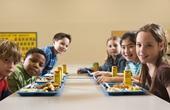Feeding school-age children

For a school-age child, nutrition is important. It determines such moments as the number of meals and the interval between them, the number of calories per each reception, the qualitative usefulness of the products for a separate reception, and the distribution of the ration for meals during the day.
Relaxed children who suffer from various chronic diseases, as well as primary school students and extended-day groups, can recommend a five-fold diet. In addition, it is desirable to use the same regime for schoolchildren during the summer vacation period, when their energy costs are significantly higher than in the winter period.
Special attention should be paid to the problem of providing essential vitamins for adolescents aged 14-18 years. In this age period, very often there is a monotonous or not completely nutritious diet, in some cases complicated by smoking, which increases the body's need for vitamin C.
Also this period is in many cases characterized by the abuse of foods high in carbohydrates or diets to get rid of excess body weightand, in addition, the lack of a conscious attitude towards one's own health, etc.
Available data indicate that regular consumption of multivitamin preparations in the puberty and prepubertal periods allows to avoid the occurrence of a number of chronic diseases in the future, and to increase the overall resistance of the organism.
Food balance for essential amino acids should have an initial value in the course of compiling a diet. It should be borne in mind that 1.5 liters of milk, or 200 g of beef, or 200 g of cod, or 0.5 kg of bread, is able to provide a person with a mass of 70 kg with all essential amino acids.
Also in the consumed foodstuffs all the necessary spectrum of mineral salts and vitamins should be contained. It is recommended to introduce vegetable vinaigrettes with vegetable oil( 20 g) into the diet - carrots 100 g, cabbage 100 g, apple 100 g, lemon 20 g with skin. These products are able to provide a complete daily requirement for vitamins A, beta-carotene, and vitamin C, as well as 50% of the need for other vitamins, mineral salts and fiber.
Materials used:
Shilov VN, Mits'yo VP"Healthy food"
